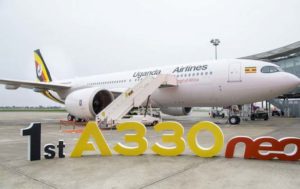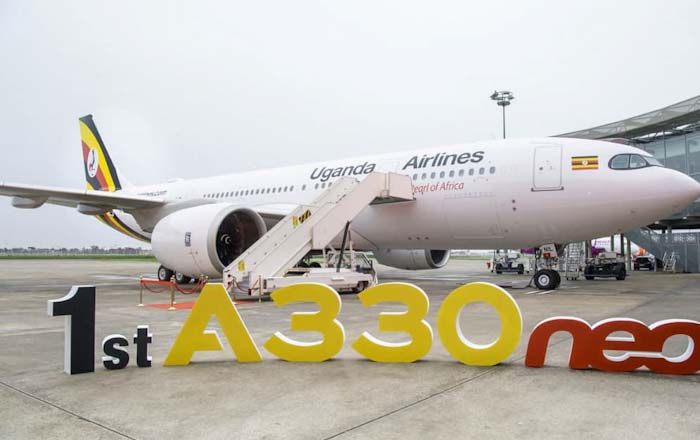Business
A330-800 gives Uganda Airlines freedom of the skies

Uganda Airlines’ A330-800 is the first of its kind on African soil
Call it new wine in old skin! The A330-800 that was on December 22 inducted into Uganda Airlines’ was born as Airbus’ answer to rival Boeing’s Boeing 787 Dreamliner.
Airbus proposed a rejig of its proven and trusted A330 with a new wing, engines, cockpit, interior and an aerodynamic cleanup.
However, hooked by Boeing’s all new concept of a composite fuselage and mostly electric aircraft, airline customers tasked Airbus to do better. The answer was the next generation A350XWB in three models – the 800,900 and 1000.
While it shelved the designs, Airbus did not abandon the project. When the Dreamliner entered service and soon ran into problems with its electrical system, operators discovered that the A330 could actually perform the same mission as the 787 at a fraction of the cost.
Airbus dusted its drawings and offered the A330-neo (new engine option) to customers. The result was a modern aircraft equal to the latest designs in operation but based on the cross-section of the venerable A330; one of only three aircraft models that have sold more than 1500 examples.
Uganda Airlines was the first airline in the world to purchase the A330-800 when it placed an order for two aircraft during the Farnborough Airshow in July 2018. Kuwait Airways followed later with an order for 8.
An undisclosed customer completes the orderbook for now with an order for 4 units. Uganda Airlines is also the first to fly the -800 in Africa and the second in the world.
With a range of 15,094 kilometres, Uganda Airlines can fly to most places on the globe non-stop from its Entebbe base. Uganda’s addressable markets in Asia, Europe and the America’s can all be reached using this aircraft.
Most interesting however, is that the -800 is so versatile, that it can still be profitably used to operate high density medium-range routes such as Entebbe Lagos and beyond. Even sectors as short as Entebbe-Kinshasa can be economically operated using this aircraft. A second A330-800 will join in the fleet capping fleet development for a while.
With the acquisition, Uganda Airlines sends a strong message that it means business. The rapid transition from a regional airline with four Bombardier (now Mitshubishi) CRJ-900’s, to one with a 260 seat widebody aircraft, marks one of the boldest fleet strategies of any airline.
Typically, airlines want to test the water, building a regional network for three to five years, before embarking on long haul operations. Risky as it is, Uganda Airlines strategy was informed by opportunities that existed in the pre-Covid-19 world.
British Airways pulled out of Uganda in 2015, as it pursued a new strategy focused on premium markets. That removed the only direct connection to London out of Entebbe. The 35,000 passengers a year UK-Uganda market translates into three flights a week at a comfortable 86percent load factor.
Even if you factored in leakages from indirect traffic through other hubs, London-Entebbe is still a solid business proposition.
Uganda Airlines’ has indicated that the two new aircraft will be used to launch services to Dubai, London and Guangzhou.
During the delivery ceremony at Entebbe International Airport, President Museveni said the two aircraft would support Uganda’s business and tourism markets.
Europe remains the biggest source market outside Africa for Uganda’s tourism. Dubai and Guangzhou are key procurement hubs for Uganda’s business community.
The -800neo is designed to carry 220-260 passengers across a three-class seating arrangement over a distance of 8,150 nautical miles or 15,094kilometres. It can also accommodate 406 passengers in single class seating.
Powered by Rolls-Royce Trent 7000 engines, the aircraft burns 14 percent less fuel per seat than its processor. Uganda Airlines has chosen a 261-seat cabin with 20 passengers in business class, 28 in premium economy, and 213 in economy class.
With the upper end of the market plugged for now, the next phase of Uganda Airlines fleet development will see the introduction of aircraft that seat between the 76-seat CRJ and the 260 seat A330.
These will become necessary as traffic becomes heavier on regional routes and new intermediate market opportunities as African skies open up.
Comments



























